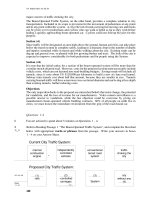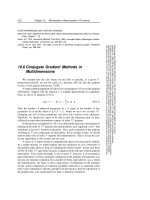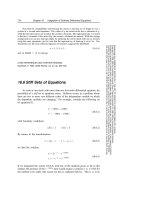Tài liệu Opportunities in technical writing careers part 7 ppt
Bạn đang xem bản rút gọn của tài liệu. Xem và tải ngay bản đầy đủ của tài liệu tại đây (97.41 KB, 10 trang )
• Editor, nursing journal
• Editor/writer to report on technology in robotics field
• Editor/writer for medical journal
• Business writer for management consulting firm
• Editor to coordinate production of proposals for computer
services
• Experienced writer of government proposals
• Newsletter editor for part-time work in university for space
research group
The Career Center of the STC website is a tremendous resource
for anyone seeking a position in this field. Society members can
post résumés, view job listings, and create a personal job alert and
a career account to track their job search.
Letters of Application
Once you have the name of a potential employer, you are ready to
write a letter of application with which you will include a résumé
of your accomplishments. There are various ways to write this let-
ter, which is also called a cover letter, but regardless of the format
you use, certain points should be followed.
The application letter should be short, but it should include per-
tinent information about your background and the type of position
you are seeking. If you are sending the letter in response to a spe-
cific ad, mention the date, publication or website, and job title. If
a mutual friend or professional contact has suggested that you con-
tact the company, you should mention it. Strive for a tone of enthu-
siasm, knowledge of the requirements of the company to which you
are applying, and adequate training, all of which will catch the eye
of the recipient.
Getting Started 51
Your application letter will be accompanied by a résumé, but it
is best not to mention the attached résumé until the end of the let-
ter. If you point it out too soon, the reader of your cover letter will
turn to the résumé before finishing what it is you have to say about
yourself.
Résumés
Preparing a résumé falls outside the scope of this book, but there
are many resources you can consult on résumé writing and for-
matting. The Recommended Reading section at the end of the
book includes some titles that can help you choose the best format
and style.
Whichever type of résumé you decide to prepare, remember
that, like your cover letter, it must be perfect. You can’t proofread
either document too many times, especially since you are applying
for a writing position. A sloppy presentation or poor writing will
not convince employers that you’re the technical writer they are
seeking.
Be sure to submit your letter and résumé in the format
requested. For example, if an employer requests electronic résumés,
don’t mail a hard copy instead. Following that initial instruction is
important, so be prepared to submit your credentials as requested.
Salaries
According to the Society for Technical Communication, the
median annual salary for entry-level technical writers was $42,500
in 2004. The median annual salary for midlevel nonsupervisory
technical writers was $51,500, and for those in senior nonsupervi-
sory positions, $66,000.
52 Opportunities in Technical Writing Careers
The U.S. Bureau of Labor Statistics reports that during the same
period, median annual earnings for salaried technical writers were
$53,490. The majority earned between $41,440 and $68,980,
while the lowest 10 percent earned less than $32,490, and the high-
est 10 percent earned more than $86,780.
As you are looking at salaries, remember that certain basic prin-
ciples do apply:
• Graduating with a bachelor’s or master’s degree in engineering
or science can help you to command a higher beginning salary than
a degree in English or some other nontechnical subject.
• A degree from certain prestigious colleges also usually adds to
your marketability and may bring a higher salary than a degree from
a lesser-known school.
• The higher your course grades, the more summer experience
you’ve had, and the more you can display characteristics of ability
and initiative, the higher your salary is likely to be.
• With a degree in an area such as electrical engineering and
electronics, you may be in greater demand than students with train-
ing in other areas.
• As a beginning technical writer, you will most likely be eval-
uated very closely on the basis of your educational record, writing
ability, and potential for being promoted.
Getting Started 53
This page intentionally left blank
4
Duties of the
Technical Writer
With a degree in technical writing, you will be qualified to pur-
sue any one of the career paths listed in Chapter 1, but some spe-
cializations seem to offer greater opportunities than others. In this
chapter we examine the different specializations and the opportu-
nities they present.
Technical Presses
Technical journalism surrounds us; in fact, the number of publica-
tions, periodicals, magazines, trade journals, and newspapers is so
great that we take their existence for granted and hardly notice their
presence. There are so many scientific and trade publications that
it is impossible to cite a number with which everyone will agree. In
addition, new publications are constantly appearing.
55
Copyright © 2008 by The McGraw-Hill Companies, Inc. Click here for terms of use.
Scientific Journals
The text and subject matter of these publications range in com-
plexity from the highly scientific Journal of Organic Chemistry to
the very simplistic magazine Popular Mechanics. The Journal of
Organic Chemistry is found only on the bookshelves of chemistry
and technical libraries and in the offices of chemists. Naturally,
most of its readers are organic chemists, and it is not generally avail-
able to the public at large. Similar journals would be the American
Journal of Physiolog y, the Journal of the American Medical Associa-
tion, the New England Journal of Medicine, Chemical Engineering,
Brain Research, and many others.
The articles published in scientific journals are generally written
by the scientists who are involved with the work. In most cases, the
articles present the findings of extensive research projects. The
authors’ names appear directly under the titles, followed by the
institutions with which they are affiliated. In academic institutions,
papers presented for publication often are written by the graduate
students who actually did the work, while the professors in charge
provide guidance and lend their names to the final publication.
Sometimes, professors who did their own research hire or supervise
graduate students to do the actual writing, although the students
in this case would remain anonymous. In industrial concerns, the
preparation of papers is usually done by technical writers to enable
the authors to engage in “more productive work.”
Papers presented to scientific journals for publication undergo a
process called peer review. After the paper has been submitted to a
journal, the managing editor sends copies to recognized authorities
in the field who carefully examine the paper for originality of work,
correctness of experimental procedures, and validity of the claims.
Very few manuscripts are accepted after an initial review. In the
56 Opportunities in Technical Writing Careers
majority of cases, the paper is returned to the authors for revision,
based on the constructive comments of the reviewers. If the review-
ers have major objections to the paper, they recommend rejection
and state the reasons for their decision, telling the authors what they
must do to satisfy the objections. The majority of authors will com-
ply with the reviewers’ comments and do additional work to make
the paper acceptable for publication. If a paper has been rejected
by one journal, it is not acceptable for the authors to present it to a
different journal without disclosing the first rejection. It is not
unusual for a paper to be presented and rejected several times before
it is finally published. This process reduces plagiarism and fraud
and ensures scientific integrity.
Scientific journals are vitally important to the community they
serve. They allow the dissemination of valuable information and
research results that can aid other scientists in their own work. In
addition, researchers whose work is funded by grants are obligated
to write up and submit the results of their work, and the number
of accepted papers serves as a strong recommendation when the sci-
entist applies for future funding. The same is generally true for
those employed by academic institutions, where promotions and
tenure can be influenced by the number of an applicant’s publica-
tions. “Publish or perish” is a popular expression in both settings.
Trade Magazines
There are many scientific and technical magazines that are sold to
the general public. These include Scientific American, Science, PC
World, Psychology Today, Popular Science, and the aforementioned
Popular Mechanics. The first two magazines often contain articles
every bit as sophisticated and mathematical in content as those pub-
lished by scientific and medical associations. Magazines like Popu-
Duties of the Technical Writer 57
lar Science and Popular Mechanics are intended for people who may
know little about science or technology but who are interested in
these subjects. The writers for these magazines must be able to inter-
pret and present scientific material in such a way as to make it
understandable and attractive to their lay readers. The success and
longevity of these magazines speak for themselves.
Company Magazines
Your first job as a technical writer may be with a company maga-
zine, such as Raytheon’s Technology Today, which highlights the
company’s technological projects. Sometimes the table of contents
contains a wide variety of articles on technology. At other times, an
issue is devoted to discussing a particular field in depth. In either
case, you would probably be writing some articles of your own or
editing other people’s articles.
The primary reason engineers and scientists write articles is to
communicate knowledge. They may be engaged in research, may
have developed a new technique, or may have been called on to
publicize something for their companies. There is also the prestige
factor—the author’s professional reputation is enhanced when his
or her articles are accepted and published.
In working on a company magazine, you will be helping others
prepare their articles. Most of these magazines consist of three
departments: editorial, advertising, and production. As a writer, you
will be assigned to the editorial department, but if you should
demonstrate advertising or production ability, you may be able to
transfer to these departments.
One of the best features of working for company magazines is
that they are likely to operate with small staffs on a fairly informal
basis. This often results in interesting working conditions, and you
58 Opportunities in Technical Writing Careers
may find yourself doing a variety of things, such as writing origi-
nal articles, editing articles written by others, editorializing, and
carrying out special assignments.
Sometimes a company magazine can be published by only one
or two people working with a printing firm and outside advertis-
ing staff, or it may be produced in-house using computers and laser
printers. It can have a much larger staff, including editors, proof-
readers, copyreaders, illustrators, office support staff, and an edi-
torial board.
Working on a company magazine will bring you in contact with
many people, which will require patience and tact on your part. In
the first place, you must persuade the engineers and scientists to
write for you, and they can be very busy people who often are not
particularly interested in whether they get published.
Most editorial boards start preparing an issue of a magazine by
having a “think session.” From this starting point, many of the
things said about company magazines can be equally applied to
commercial technical magazines.
A think session occurs when the magazine’s staff gets together
to decide what will go into a particular issue. And you may be sur-
prised to learn that magazines work six, seven, or eight months in
advance. It takes weeks and weeks to produce an issue, from the
idea for the first article until the magazine is wrapped up and sent
to the mailroom.
One of the most fruitful sources for papers and articles is con-
ferences attended by company employees. Papers delivered at these
gatherings often turn up as magazine articles. But such selection is
planned with several factors in mind. The editor may decide to con-
sult the public relations department to determine what is going on
in the company that will appeal to readers. In addition, manage-
Duties of the Technical Writer 59
ment must be consulted, because in the long run, responsibility for
the magazine rests with the company’s administrators.
Once you have received a manuscript from an author, the real
job of writing and editing begins. This is when the experience you
have gained in your writing classes will come into play. Although
the people from whom you get the material may (or may not) know
how to write, it is very likely that they haven’t paid attention to their
potential readers. So determining the audience becomes your job,
and you must fit the style and tone of the piece to the audience you
are trying to interest. For example, you may have to write a com-
pletely new opening for an engineer’s paper to attract readers’ atten-
tion. Here is where your job is perhaps most satisfying—and
sometimes most frustrating—as you try to weld unorganized mate-
rial into acceptable form. Changes of any sort, of course, necessi-
tate conferences with the author, who must be as satisfied with the
final product as you are.
The manuscript must be reviewed to be sure it fits the prescribed
editorial format. It is then turned over to the appropriate staff mem-
bers for illustration and layout.
Professional Magazines
Professional magazines are published by professional societies. Some
examples of these are the Journal of Chemical Education, published
by the American Chemical Society; Civil Engineering, by the Amer-
ican Society of Civil Engineers; and the American Journal of Nurs-
ing, by the American Nurses Association.
A great many journals are read by audiences outside of the
company. For this reason, a technical journalist must be able to
gauge the interest and needs of these external readers and to pro-
duce material that is “reader friendly.” The ability to analyze these
60 Opportunities in Technical Writing Careers









